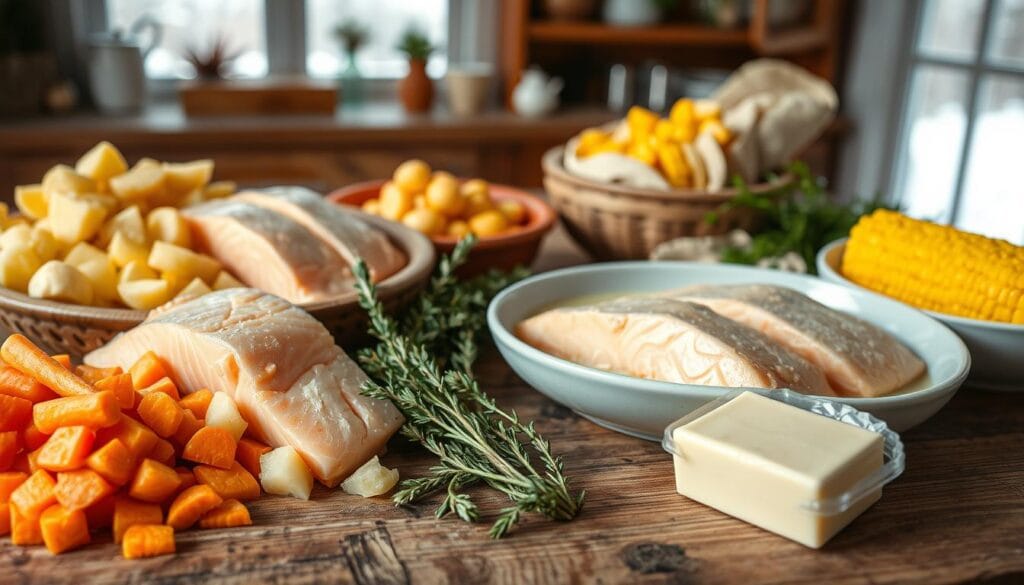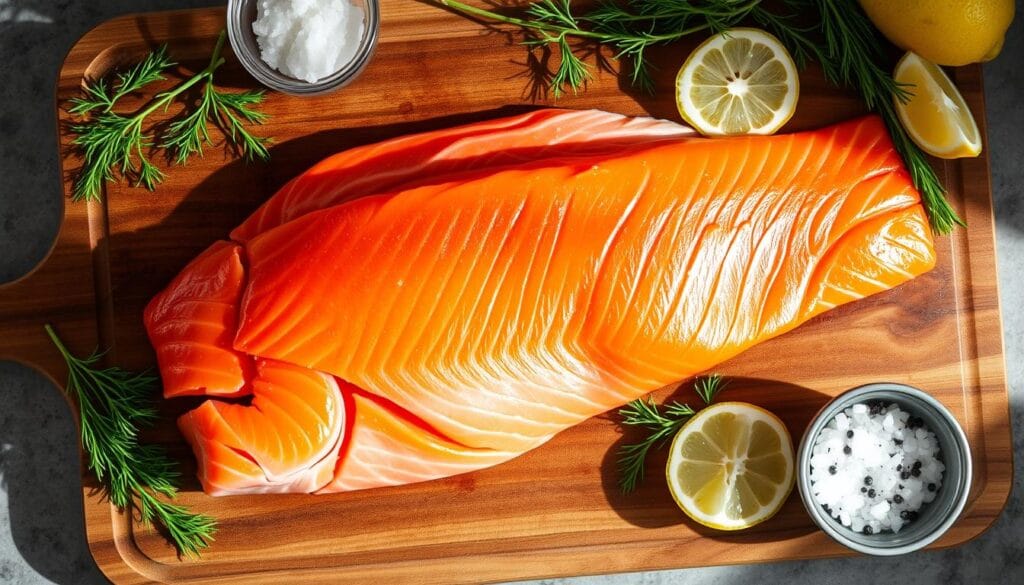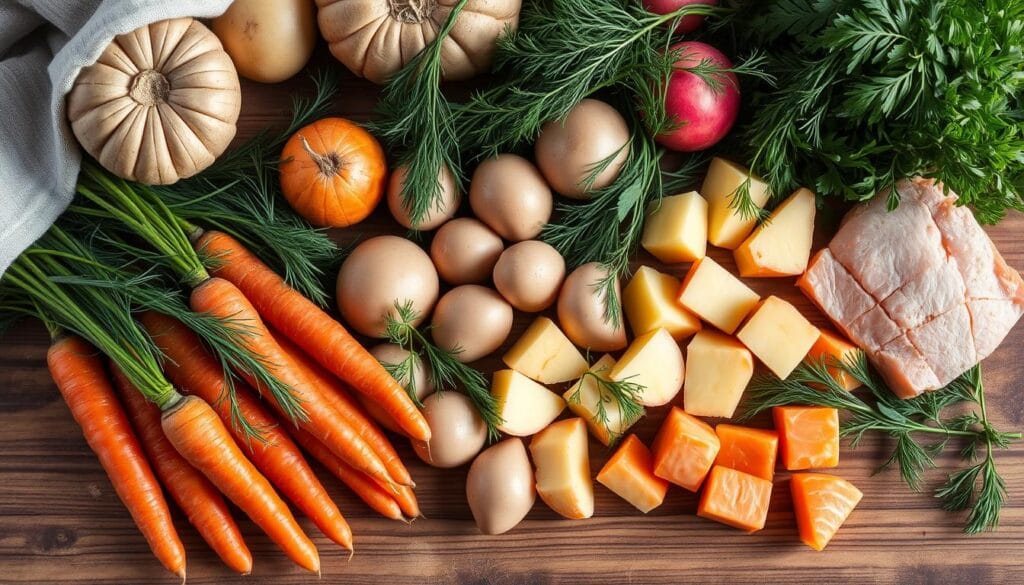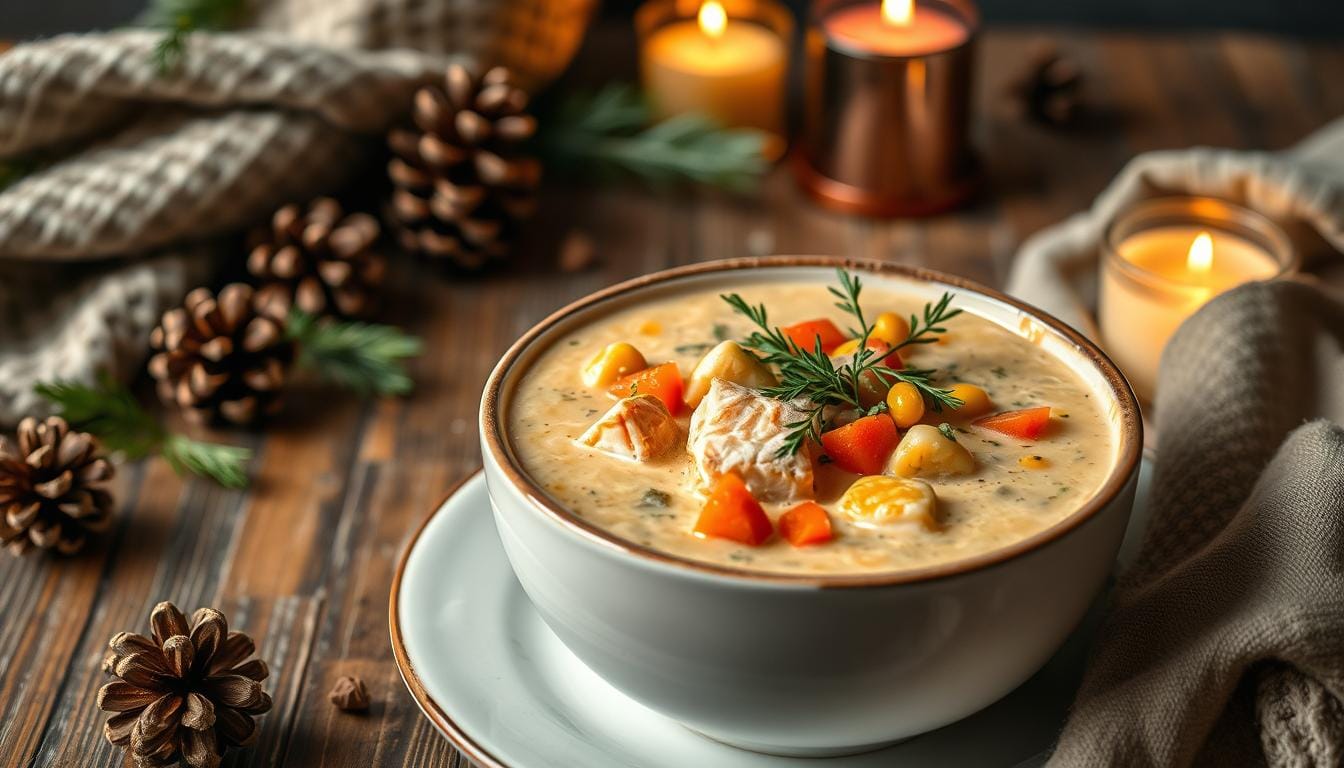Cozy Winter Salmon Chowder: A Hearty Bowl of Comfort
When it gets cold outside, nothing beats a warm bowl of salmon chowder. It’s creamy, full of flavor, and perfect for the chilly weather. It’s made with tender salmon, fresh veggies, and a smooth broth that warms your heart.
This soup is great for when you need something warm and filling. Or if you just want a cozy meal, this chowder is the way to go.
The chowder’s creamy texture is amazing. It combines flaky salmon with crisp veggies for a taste that’s both comforting and refreshing. As winter comes, this soup is a warm, nourishing friend. It’s the perfect mix of comfort and health to keep you cozy.
Table of Contents
Why Winter Salmon Chowder Is the Ultimate Comfort Food
When it gets cold and the days are short, a warm bowl of seafood soup is just what you need. Salmon chowder is the top pick for a cold weather meal. It’s not just tasty; it’s also packed with health benefits perfect for winter.
Health Benefits of Salmon in Winter Dishes
Salmon is full of omega-3 fatty acids, great for your heart and brain. In the cold months, our bodies need more nourishment. Salmon’s omega-3s help keep us healthy and fight off winter sickness.
The Appeal of Creamy Seafood Soups
A creamy seafood soup like salmon chowder is a joy on a cold day. It combines tender seafood, fresh veggies, and a creamy base. It’s a comforting meal that warms you up and delights your taste buds.
For a cozy, filling meal, try homemade salmon chowder. It’s the perfect comfort food for winter.

Essential Ingredients for the Perfect Salmon Chowder
Making a delicious winter salmon chowder needs the right mix of seasonal ingredients. At its core is the star, high-quality salmon. It brings a rich flavor and soft texture. Alongside the salmon, various vegetables add to the dish’s balance.
To make the best salmon chowder, you’ll need:
- Salmon – Fresh, wild-caught salmon is best, offering great taste and health benefits.
- Potatoes – Starchy potatoes, like Yukon Gold or russet, thicken the chowder and make it creamy.
- Onions – Diced onions add depth of flavor and aroma to the chowder base.
- Celery – Crisp celery stalks add a subtle crunch and freshness.
- Carrots – Vibrant carrots add color and a hint of sweetness.
- Cream or Milk – A dairy element, such as heavy cream or whole milk, gives the dairy-based chowder its signature texture.
- Fresh Herbs – Fragrant herbs like thyme, parsley, or dill add a fresh, herbal flavor.
By mixing these key ingredients, you can make a winter salmon chowder that’s both cozy and flavorful. It highlights the salmon’s delicate taste while adding a variety of seasonal ingredients.
| Ingredient | Role in the Chowder |
|---|---|
| Salmon | Provides the main flavor and protein source |
| Potatoes | Thickens the chowder and adds creaminess |
| Onions | Adds depth of flavor and aroma |
| Celery | Contributes a subtle crunch and freshness |
| Carrots | Provides a touch of sweetness and vibrant color |
| Dairy (Cream or Milk) | Creates the signature dairy-based chowder texture |
| Fresh Herbs | Lends a fresh, herbal note to the chowder |

The Art of Selecting and Preparing Fresh Salmon
Creating the perfect salmon chowder starts with choosing the freshest salmon. You’ll want to know the difference between wild-caught salmon and farm-raised. Also, learning how to prepare it is crucial.
Wild-Caught vs. Farm-Raised Salmon
The choice between wild-caught and farm-raised salmon is a common debate. Wild-caught salmon is known for its bold flavor and high omega-3 levels. Farm-raised salmon, on the other hand, has a milder taste and consistent texture. Your preference will guide your decision for your chowder.
Proper Salmon Preparation Techniques
Proper fish preparation is key for a delicious chowder. Start by rinsing the salmon fillets under cold water and pat them dry. Then, remove any bones carefully with a sharp knife. Choose whether to keep the skin on or off, based on your taste and recipe needs.
Best Salmon Cuts for Chowder
For the best salmon cuts in chowder, go for the center-cut fillet. It’s tender, flaky, and flavorful, perfect for your chowder. You can also cube the salmon for a burst of sea flavor in every bite.

New England Style Influences in Winter Salmon Chowder
Winter dishes don’t get cozier than a New England-style salmon chowder. This dish is known for its creamy texture and bold flavors. It’s a favorite in many homes across the country.
Fresh, sustainable salmon is at the heart of this dish. Its firm texture and sweet taste pair well with the chowder’s flavors. The New England touch makes it special, with its unique ingredients and cooking methods.
- The use of heavy cream or half-and-half to create a lusciously creamy broth
- The inclusion of diced potatoes, which lend a hearty, satisfying texture to the chowder
- The addition of smoky bacon, which adds a delightful salty-savory note
- The gentle seasoning with herbs like thyme, bay leaves, and parsley
This combination of elements, with the fresh salmon, makes a comforting chowder. It’s perfect for a cold winter evening or a cozy lunch. This dish shows how regional cuisine can warm both body and soul.

Step-by-Step Cooking Method for Creamy Fish Stew
Making the perfect creamy fish stew is all about balance. It’s a mix of cooking skills and the right ingredients. Let’s go through the steps to make your winter salmon chowder rich, flavorful, and satisfying.
Base Building and Seasoning
Begin by sautéing onions, celery, and garlic in butter or olive oil. This is the base of your stew. Season it well with salt, pepper, and herbs like thyme, bay leaves, and paprika.
Incorporating Dairy Elements
- After the veggies are soft, add a roux of flour and milk or cream. This thickens the stew and makes it creamy.
- Slowly add fish or vegetable stock. Let it simmer to blend the flavors.
- Then, add your salmon chunks. Let them cook gently in the creamy broth.
Final Cooking Tips
- Don’t overcook the salmon. It should be just done. Remove from heat when it’s cooked.
- For extra richness, add butter or heavy cream before serving.
- Check the seasoning. Add more salt, pepper, or herbs if needed.
Follow these steps to make a comforting and tasty creamy fish stew. It’s perfect for a cold winter day.

Seasonal Vegetables and Herbs to Enhance Your Chowder
Winter brings a bounty of ingredients and aromatic herbs to make your salmon chowder better. These fresh items add color, texture, and flavor to your dish. They also make the creamy base even richer.
Begin with root veggies like carrots, parsnips, and potatoes for a hearty touch. Celery and onions create a classic aroma. Adding fresh thyme, rosemary, or bay leaves brings a warm, earthy taste.
- For a nutritional boost, add kale, spinach, or chard towards the end. These greens make your dish look great and add important vitamins and minerals.
- Try the fennel bulb for a unique flavor and a tender texture. It pairs well with salmon.
- Finish with a sprinkle of parsley, chives, or dill for a fresh aroma and a nice look.
By adding these seasonal ingredients and aromatic herbs, your salmon chowder will be both comforting and a true winter delight.

“The secret to a truly exceptional chowder lies in the perfect balance of seasonal flavors and textures.”
Serving Suggestions and Pairing Recommendations
Make your winter meals special by pairing salmon chowder with the right sides. Warm, crusty bread is a great choice. It goes well with the creamy broth and fish. Try offering different breads like sourdough, flaky biscuits, or buttery rolls.
For a fresh touch, serve the chowder with a green salad or a side of roasted veggies. Options like Brussels sprouts, asparagus, or a celery and fennel slaw add a nice contrast to the chowder.
Wine and Beverage Pairings
Finding the right drink can make your meal even better. Here are some wine and drink suggestions for your winter salmon chowder:
- Crisp white wines, like Sauvignon Blanc or Pinot Grigio, complement the chowder’s creamy texture and seafood flavors.
- Medium-bodied red wines, such as Pinot Noir or Malbec, add a cozy warmth to the meal.
- For those who don’t drink alcohol, try a citrusy sparkling water or a creamy hot chocolate for a nice contrast.
The secret to a great chowder experience is finding the right mix of flavors and textures. Whether it’s with warm bread, a fresh salad, or a perfect drink, it’s all about balance.

| Bread and Side Dish Options | Wine and Beverage Pairings |
|---|---|
|
|
Storage Tips and Reheating Guidelines
Enjoying leftover chowder doesn’t have to stop after the meal. With the right storage and reheating, you can enjoy its flavors for days. Here’s how to keep your leftover chowder fresh and tasty.
Refrigerator Storage
After it cools, put the chowder in an airtight container in the fridge. Leftover chowder stays good in the fridge for 3-4 days. Don’t forget to label it with the date and what’s inside.
Freezer Storage
To keep it longer, freeze the leftover chowder. Let it cool, then put it in a freezer-safe container or bag. Frozen leftover chowder stays good for up to 3 months.
Reheating Tips
- Thaw frozen leftover chowder in the fridge overnight before reheating.
- Reheat leftover chowder on the stovetop over medium heat, stirring often, until hot.
- Avoid quick or uneven heating to prevent dairy from curdling or seafood from getting tough.
- For food safety, make sure it heats to 165°F (74°C) before eating.
By following these easy tips, you can enjoy your leftover chowder for days. Savor every bite while keeping it safe to eat.
Conclusion
Winter salmon chowder is the ultimate comfort food. It combines rich, creamy flavors with the health benefits of fresh salmon. By following the tips and techniques in this article, you can make your own delicious version.
This dish is perfect for a nourishing meal on a cold day. It has tender salmon, soothing vegetables, and a creamy broth. It offers a comforting and satisfying dining experience.
Feel free to experiment with different ingredients and techniques. Winter salmon chowder can be customized to your liking. So, gather your ingredients, fire up the stove, and enjoy the comforting goodness of this winter wonder.

